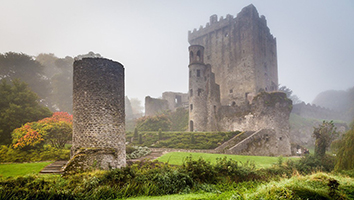
Lordships/Septs of Other Families directly under a MacCarthy Mor:
- O Donoghue Mor
- O Sullivan Mor
- Etc.(to include their subordinate Septs)
- The Lordship of Dunkerron. Not re-granted by the MacCarthy Mor.
Originally the possession of the O SULLIVAN MOR, Chief-of-Name, the last acknowledged as such died in 1754-1762.The O Sullivan Mor as branched from the Eoghanacht Royal House and head of the major Desmond chiefship under MacCarthy Mor was always entitled to use the styling of ‘prince’ and was often referred to as such.
O Sullivan Mor in the late 16th century had the sole right or office of bestowing the white wand of legitimacy to a valid MacCarthy Mor (earlier that right had been shared with O Donoghue Mor, prior to the attainder of O Donoghue Mor for rising in rebellion with the Earl of Desmond).
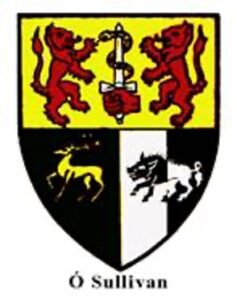
O Sullivan Mor indeed refused that wand to Donal the ‘base son’ of the last reigning MacCarthy Mor (who had the best claim) in favour of his brother-in-law, Florence MacCarthy of Carbery, who had as said married the legitimate daughter of the last MacCarthy Mor. Definitely politics and family loyalties existed in that situation.
There were many O Sullivan lordships / septs d ependent historically on O Sullivan Mor, though depending on their location they were often subject to ‘extractions’ or certain payments to others such as the MacCarthys of Carbery or the Earls of Desmond.
These branches/septs of the family follow, with comments on other families as appropriate:
1. The Lordship of Dunboy
- Extinct in the 17th century.
- Now in possession of The MacCarthy Mor and not regranted.
Originally the possession of the very famous O SULLIVAN BERE comital branch of the O Sullivans, Chieftains of the Name in Cork, and seen as second in rank to the O Sullivan Mors.
The O Sullivan Bere in addition to his castle at Dunboy also had castles/manors of his own possession at:
- Ardea (held historically by his Tanist);
- Bantry; and
- Carriganass
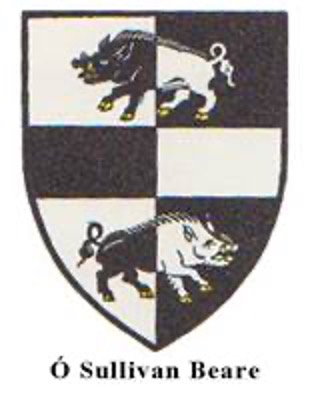
And a number of other O Sullivan baronial / manorial lordships, as follows:
- the other O Sullivan septs subordinate to O Sullivan Bere are:
- Sliocht Fineen Duff (survived at least into the 19th century);
- Sliocht Dowlinge;
- Sliocht Swleagwill; and
- the Sept of Ballaghbuy …
- plus the lands of freeholders in Bantry, etc., of which the Association at present knows nothing re any lineal descents.
Additionally, O Sullivan Bere had as dependent a number of non O Sullivan clans:
O Linchigh (O Lynch), which was Gaelic and had nothing to do with the Norman-Irish Galway Lynches, and which was of the same Corca Laoighdhe roots as the O Driscolls.
They were Lords of Kilcaskan and likewise lost all in the 17th century wars but continued on to include;
- Jack Lynch, Taoiseach of Ireland two times;
- the families of O Holighan;
- O Donegan; and
- the soldierly family of Harrington.
Harrington had a Chief-of-Name listed in 1576 but nothing survives as regards an hereditary descendant to claim the lordship / chiefship-of-name of any of those non O Sullivan families.
Finally, there was a branch of the Lyons family living as tributary to O Sullivan Bear, to include one from that medical family being the physician to Domhnall Cam in Spain in the early 17th century.
2. The Lordship of Clanlauras
It became a major O Sullivan lordship as it had become virtually independent of O Sullivan Mor and of claims by O Sullivan Bere (to whose territories it was contiguous); but it was extinct by the late 16th century – when it reverted directly to the then reigning MacCarthy Mor.
However, the consensus is that this large former O Sullivan lordship, whatever the previous reversion directly to a MacCarthy Mor, should again be listed under the branches of the O Sullivans – as stemming originally from the O Sullivans as an appanage and being a subordinate branch of that family, with note that Clanlauras itself became a comital / Ard Tiarna lordship.
3. The Lordship of Doonebo
The current Lord of Doonebo lives on an estate in Lincolnshire, England and is a member of the Standing Council of Irish Chiefs. He was educated in England 1948-57, Switzerland (1958), France (1962-63) and England again (1969-71). He served as an officer in the Irish Guards; and was later farming in the Province of Natal, South Africa. After returning to Ireland from South Africa, he was living in MacGillycuddy Reeks Country (Baunclune / Whitefield), prior to his move to Lincolnshire.
4. The Lordship of Letter
This was the possession of the O Sullivan branch which became known as MacCrehan, and their major residence was at Letter, near Cahirciveen in County Kerry. The sept also had a manor at Magunihy. They are extinct by all knowledge to date.
5. The Lordship of Cappanacushy
This was the possession of what was originally the senior branch of the O Sullivans, who became known as MacCrah. They are extinct to all knowledge to date.
6. Other Septs of the O Sullivans
(minor to 1 to 5 above) directly subordinate (baronial or manorial lordships) to O Sullivan Mor
There were at least eight, and these are:
- O Sullivan of Cumurhagh;
- O Sullivan of Glenbeigh;
- O Sullivan of Caneah and Glanarcane;
- O Sullivan of Culemagort;
- O Sullivan of Cappanacuss;
- O Sullivan of Capiganine;
- O Sullivan of Fermoyle and Ballycarna; and
- O Sullivan of Ballyviegillaneulan.
None has been claimed by a lineal hereditary of any of those septs to the Association’s knowledge, though descendants continued in Counties Cork and Kerry after the end of the Gaelic order and confiscations.
Therefore, as with the principalities of Carbery and Muskerry of the MacCarthys, it is our belief that a lineal hereditary head for one or more of these O Sullivan subordinate septs possibly still exists! But much work must be done by current O Sullivans re tracing the ancestries / decendancies.
Note: re the O Sullivans, the above may not be entirely accurate, and the Association invites comments re revisions.
The Lordship of Lough Lein
This was held in heredity under the MarCarthy Mors by the senior branch of the O Donoghues, who came from the Ui Eachach Cinel Laeghere branch (thus royal blood, use of styling ‘prince of Lough Lein’ etc).
In Kerry since the early 11th century, their lands had also been confirmed to them by The MacCarthy Mor after the Battle of Callan, 1261. The head of the family is known as O Donoghue Mor, Chief-of-the-Name.
The family had been considered extinct from the crushing of the Gaelic order, as noted in numerous histories.
The O Donoghue Mor sided with the Earl of Desmond in his rebellion (1579-1583) and had his lands confiscated by the British government, the rights of the family reverted to the MacCarthy Mors at that time even though a legitimate O Donoghue Mor continued to exist. This was unjust but given the collapse of the Gaelic order after Kinsale there was really nothing further that could be done to correct injustices to O Donoghue Mor.
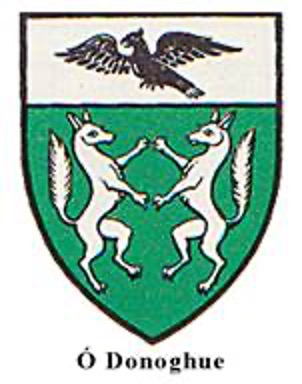
It is hoped that there may be a bloodline descendant yet to be found, or that the senior of Lough Lein will be claimed by O Donoghue of the Glens (see next).
The main residence of O Donoghue Mor was at Ross Castle.
UPDATE April 2012: it is with pleasure that we report that there indeed is a legitimate O Donoghue Mor extant! And that the ‘numerous’ histories claiming that the line is extinct are incorrect (which unfortunately is the case with many Irish genealogical histories, where one error is picked up and perpetuated for centuries, etc.). We wish to thank the O Donoghue Clan Society for this information and we encourage publication of a full scholarly article concerning the descents of O Donoghue Mor. See the O Donoghue website which is linked to our own for much additional history and insight.
The Lordship of Glenflesk
This has been held continuously and in hereditary by the O Donoghues of the Glens, Chieftains-of-the-Name.
They likewise, because of branching from a royal line, have been referred to as ‘princes’.
Their historic seat was Killaha Castle.
The current O Donoghue of the Glens is a member of the Standing Council of Irish Chiefs. He is very highly regarded by all.
The family is among the few that stayed in its native area without removing to a foreign country, and various O Donoghues of the Glens made significant contributions to Irish freedom.
It is the position of the Association that the current O Donoghue of the Glens could go forward with a claim to be O Donoghue Mor. In that case the Glenflesk title could be granted by him to a junior of his house.
Update: April 2012 – see above on the confirmation by the O Donoghue Clan Society that there is a legitimate O Donoghue Mor! And it is our understanding that the claim is fully supported by the Lord of Glenflesk.
OTHER O Donoghue Septs would include:
- O Donoghue Dubh of Dromcarbon; and
- The Curraig O Donoghues, Lords of Rusheen Beg.
The Lordship of Ballymalis
This lordship was located in County Kerry contiguous to Sliocht Cormac of Dunguile of the the MacCarthys.
It belonged to the sept of O Moriarty, referred to as Sliocht Murry.
They had once been kings but much of their land had been taken by the O Donoghues by 1107, and they indeed became tributary to the Kingdom of Desmond soon after.
They nevertheless survived the centuries in much reduced circumstances, paying some chief rents to the Earl of Desmond as well as to MacCarthy Mor.
Their main residence was at the Castle of Ballymalis and, in addition, they held a secondary lordship/manor at Kilbonane.
There has been some confusion about the O Moriartys, but the Association believes that the above is correct.
Kilbonane was regranted as a MacCarthy baronial lordship, but that was technically incorrect – as it was a possession of the O Moriartys even if their chiefship is extinct and the overall lordship is now in the proper possession of the MacCarthy Mors.
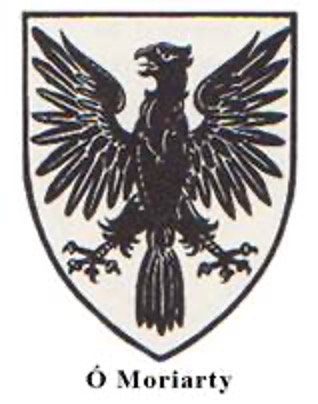
Other Families
Without going into great detail, there were certainly a number of other septs in County Kerry.
We here mention the O Sheas (who were principal before the invasions of MacCarthys, O Donoghues, O Sullivans in the 12th century);
- O Falveys;
- O Connells;
- O Griffins;
- O Lynes; and
- O Brennans, a branch of the bardic O Dalys.
All of these had chiefs-of-name and much work can be done on identifying their descendants.
Offices
It should be noted of course that the MacCarthy Mors as well as the principalities in the Kingdom of Desmond had a number of hereditary offices responsible to them for various duties. These offices were held by specific families, for example:
- the O Connells were hereditary constables of the MacCarthy Mor demesne land castle of Ballycarbery in County Cork;
- branches of the O Dalys were hereditary bards / poets to various Gaelic lords and had properties held from the MacCarthys in both Cork and Kerry;
- the O Levies (Levis) were hereditary surgeons;
- the O Doinins (Dineens, Dowlings) were hereditary chroniclers;
- the O Falveys were hereditary admirals of Desmond;
- the MacEgans were an hereditary Brehon Law legal family, serving various lords in Ireland;
- Sliocht Meirgeach O Mahony came to be hereditary Stewards of the MacCarthy Mors; and
- the O Regans were Stewards of the Prince of Carbery.
